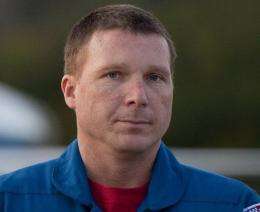US astronaut recalls 'roller coaster' of shuttle flight

Riding a space shuttle is sort of like surging skyward aboard a high-speed, rickety roller coaster and then returning through a pulsing cosmic nightclub, US astronaut Terry Virts says.
Asked to describe his most savored moment in space, the Air Force colonel and 11-year NASA veteran was unable to settle on a single high point during his first and only two-week flight aboard a space shuttle last year.
"Every day I had a favorite memory," Virts told AFP in an interview at Kennedy Space Center as Atlantis was poised to make its final journey to the International Space Station, marking the end of the 30-year shuttle program.
"The launch itself is amazing -- the sounds and the sights," he said.
"In 20 years of being a fighter pilot and test pilot I never felt anything like that before," said Virts, 43, who piloted Endeavour to the orbiting lab in February 2010.
"You are accelerating, so in some ways that's like pulling g's. There is a lot of noise. It's kind of like an airplane but it sounds like a train -- just really loud because there is so much wind pressure on the windows.
"The vibration is like riding one of those old wooden roller coasters that rattles your head, only a lot more," he said.
"It is an amazing experience."
An astronaut barely has time to catch a breath after jolting toward space when suddenly, the first majestic sights of Earth come into view.
"Around a minute into the flight... I could see the whole East Coast of the country," said Virts.
"A couple minutes into my space flight I'm like 'Hey, there's America,' you know?
"Then a few minutes later I'm floating in space and there's the sunrise and the jets are banging and it sounds like a shotgun going off. They are really loud jets," he said, describing the process of the rocket boosters falling away about 30 miles (45 kilometers) above the earth.
"There is flashing, and then they separate from the tank and they burn for 10 seconds or so, and it's an unbelievable light show," he said.
"And then a few minutes later we are flying over the Alps. And that was the first day. Every day there was an experience like that."
Perhaps the only way to top the mind-blowing liftoff was to experience the fiery re-entry into Earth's atmosphere under cover of darkness.
"If you are ever coming back from space to Earth, I recommend doing it at night," he said with a laugh.
"The re-entry was even more impressive than the launch."
Plunging back into Earth's atmosphere, the crew experiences a unique light show from the plasma in the magnetosphere and the complex interplay of electric and magnetic fields that encircle and protect the planet from the Sun.
"Going through that plasma you realize it is like 4,000 degrees (Fahrenheit, 2,200 Celsius)," he said, gesturing to show that the shuttle window was about a half-meter (one and a half feet) from his head.
"You can see wires of plasma swirling around, like right by the window, you could hear a little tinkling, like little noises on the window.
"It was like a strobe light in the cockpit for probably 10 or 15 minutes where the plasma was exploding basically right over our window. It was like this flash-bang, this pulsing, flashing light."
Even though astronauts train extensively and do flight simulations to prepare for such sights and experiences, nothing can compare to going through it firsthand, he said.
"It was shocking. I knew it, I had seen videos, but doing it is like... wow."
Virts said there is plenty of nostalgia among US astronauts as they witness the end of the shuttle program, which toted up to seven crew at a time to the International Space Station for years and was the longtime centerpiece of NASA.
He also described this as a "sad time," because thousands of NASA employees are being laid off and the space agency has no solid focus for the immediate future.
Private companies are competing to build the next low-orbit space capsules by 2015 at the earliest, and NASA's own efforts to build a craft for venturing to an asteroid and eventually Mars are many more years away.
For the foreseeable future, the world's astronauts will have to hitch a ride to the orbiting lab aboard Russia's space capsules.
"There is uncertainty, and I think that is what makes it tough," said Virts.
(c) 2011 AFP


















